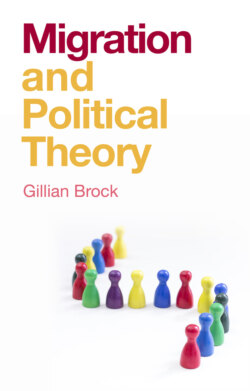Читать книгу Migration and Political Theory - Gillian Brock - Страница 10
1.2.1 Key terms
ОглавлениеPeople can be described as migrants even when they have not actually themselves migrated. For instance, children of citizens born in other lands may be categorized as migrants, commonly second- or third-generation migrants (or citizens of migrant origin). People migrate for many reasons, but the overwhelming majority migrates because of factors related to work, family, or study. There is also a huge category of forced migrations in which people migrate because of conflict, violence, persecution, natural disasters, or environmental degradation. Let us look at some commonly used terms related to migration next.
International migrants are those who cross a state border as opposed to those who migrate within a state. The terms destination, recipient, or host state refer to the country to which a migrant goes. The country she has left is commonly referred to as a state of origin, sending country, or home state.
International migration can be characterized as either intending to be permanent or for a more temporary duration. Not all migrants enter the destination state on a permanent basis, but rather some aim to reside in the country for a short period and then return home. Work and study are dominant reasons motivating people to migrate temporarily. A vast number of these temporary migrants enter for work and are called “temporary labor migrants.”
Many migrants seek to live in a state more permanently and in ways that are lawful. This usually involves at least two phases. In the first phase, the migrant, if successful, is legally admitted to reside in the territory on a permanent basis. In order to become a citizen, the migrant usually has to reside in the territory for a period of time, such as five years. During the first phase, the migrant would typically be described as a permanent resident. In the second phase, once citizenship has been conferred, the migrant might be referred to as a naturalized citizen.
Some migrants repeat patterns of migration between two destinations, such as the home and host states, often because the demands of work are seasonal. Such migration might be referred to as circular.
Next, let’s cover cases of involuntary migration. Those who cross a border fleeing war, persecution, or other significant disturbance to public order are often classed more loosely as refugees. Those displaced by such activities but who do not cross a border are classified as internally displaced people. A person crossing a border seeking refuge in another state may apply for protection in the territory, and such applicants are called asylum seekers. If the application is successful, the person’s legal status changes and they are recognized as an official refugee. Achieving formal legal status can come with certain rights and entitlements that are not afforded to asylum seekers, such as a right to work in the country of refuge.
In practice, the distinction between voluntary and involuntary migration can be rather arbitrary. Levels of coercion, in reality, fall along a continuum as migrants experience different forms of pressures that they perceive as forcing them to leave. One such huge category of pressure relates to economic conditions and opportunities in countries of origin. Many people who seek to leave their home countries are not successful in doing so lawfully. Often desperate people might feel compelled to take matters into their own hands, and they might seek to enter their desired destination state in ways that are characterized as “illegal,” “unauthorized,” “undocumented,” “irregular,” or “illegalized.” While many people have strong preferences as to which of these terms to use, I will refer to those who enter in such ways as undocumented migrants to adopt what I believe to be one of the most widely used and neutral ways of referring to members of the group.
Human trafficking involves the trade in people for purposes such as forced labor or commercial sexual exploitation. People smuggling differs from such practices in that the person being smuggled has consented to the transaction. While many cases of human smuggling may start off as consensual, the nature of the transaction may change considerably through coercive or exploitative elements, such as having to take out significant loans to repay the smugglers or others who facilitate international movement. Trafficked people are often held against their will and forced to work for the trafficker or their associates. In these situations, those trafficked can experience modern-day slavery.
